Selection and Breeding of Kalmia latifolia
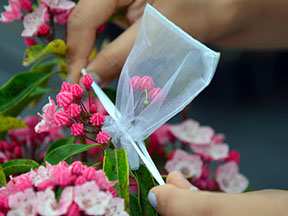
From a total of 27 cultivars we collected, field trials will be re-established with amended organic soil and randomly planted in four rows (blocks). Container plants will be evaluated in the nursery plots. Data from both field and container plants will be collected during early spring for cold hardiness rating and growth, late spring and early summer for bloom time and duration, and late fall for the plant growth and overall performance for their adaptation and heat tolerance (rating their performance during Georgia summer heat). Survey will be also conducted on cultivated landscapes in Georgia and adjacent states for the Kalmia plant performance. To summary these data, we can select better existing cultivars for further breeding.
In collaboration with Dr. Matthew Chappell, we will continue to explore the most-southern distribution of Kalmia latifolia in the wild and collect seeds. The targeted locations are coast areas of South Carolina, Georgia, Florida, Alabama, and Louisiana. Seedlings from these provenances should have better heat tolerance and will be used for further selection and cross hybridization.
Commercial reproduction of Kalmia is done by tissue culture (Lloyd and McCown, 1981). Rooting of stem cutting is very difficult and seed germination is not easy (Dirr and Heuser, 2006). For our studies, stem cutting propagation is essential for a new clone with one or a few plants. To better root Kalmia cuttings, we will collect Kalmia stem cuttings in all four seasons of the years and treat them with different types and concentrations of rooting hormones. Pre-treatment (spraying rooting hormones on the targeted stems before we remove them from the plants) and drench rooting hormones after formatting calla on prepared stem cuttings will be experimented. A protocol should be developed for rooting Kalmia stem cuttings.
During Kalmia flowering season, controlled crosses will be made among existing cultivars and field collected clones. The criteria for selecting cross pairs will be the heat tolerance, growth habit, foliage size, flower colors and types, growth rate, and overall container and field performance. Half of the hybrid fruits will be collected for immature embryo germination and the other half will be collected after seed maturation for regular germination. Seedlings will be evaluated and screened in container production and field trials. Novel clones with compact habit, bright and loaded flowers, and superior heat performance should be selected for new cultivar releases.
Ms. He Li, a Ph.D. student, is working on this project. She will be trained from cutting propagation, container production, field evaluation, cross hybridization, embryo germination, molecular marker techniques, and the woody plant breeding system. When she completes the project, she will be ready as a new plant breeder in the field of horticulture!
Ilex Breeding

From our field collections in China, two Ilex species under extreme conditions were finally germinated. Ilex bioritsensis was collected from the top of a limestone mountain and its foliage completely rolled under the extreme drought conditions (without rain for months). The plant should do well under drought conditions. Ilex metabaptista was collected on a stream with shallow running water. We will test both species for their performance under drought and flood conditions and use them for breeding lines. These effects should yield some novel clones for extreme drought and seasonal flood environmental conditions.
The bottleneck of Ilex breeding is to germinate hybrid seeds. It usually takes 2-3 years for regular seed germination. The hybrid seeds from our cross between Ilex glabra (black berries) and Ilex × meserveae (red berries) or Ilex verticillata (red berries) (have no germination yet in their 2nd year. To overcome the difficulty, immature embryo germination was successful achieved in vitro with young fruits from a potential new release of Ilex crenata ‘Sky Pencil’ seedling. Instead of 2-3 years, immature embryo could be germinated in two weeks and its sequential micropropagation (one cycle) could be completed within 6 months (Sun et al., 2010; Yang et al., 2015).
A new clone, selected from Ilex crenata ‘Sky Pencil’ seedlings, with oval compact habit is in evaluation by Greenleaf and Bailey Nurseries (Yang et al., 2014). We will select Ilex taxa with unique morphological characteristics and better environmental adaptation and make controlled crosses among them. With employment of new immature embryo germination, micropropagation and molecular marker aided breeding techniques (Yang et al., 2014), we should be able to increase superior clones of Ilex to our ornamental markets.
Two people, Dr. Youping Sun (Ilex glabra) and Dr. Yujie Yang (Ilex crenata), have successfully earned their Ph.D. degrees with their work on Ilex breeding. Both of them have the University jobs and continue to work on woody plant breeding, propagation, and production. We will continue to recruit undergraduates, MS and Ph.D. students for the Ilex breeding and train more future plant breeders.
Disease Resistance Buxus and Its Alternatives
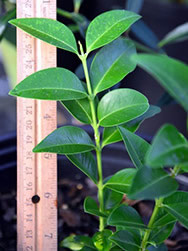
Several collections, such as Buxus henryi, Buxus ‘Richard’, Buxus ‘Maine Form’, and etc. have been evaluated in the Horticulture Farm. The goal is to select boxwood blight resistant cultivars and apply them for our future breeding. Boxwood is a popular ornamental plant and the market demand is very high (Zhang et al., 2008). Through our evaluation and breeding work, we hope to provide nursery industries with elite boxwood cultivars.
Morphologically, Syzygium buxifolium looks like a boxwood plant. Its evergreen, opposite or whorled foliage, and shrubby habit make it an ideal substitution for a boxwood plant. Syzygium is from Myrtaceae (myrtle family) and majorly distributes in tropical areas. However, Syzygium buxifolium, found in temperate zones (Hubei and Hunan of China), survived one of the coldest winters in Georgia last year. Seeds collected from these survived plants will be germinated and transplanted for further evaluation. Clones with compact, dark green foliage, and no cold and late frost damage will be trialed in the Horticulture Farm and tested on sites of several selected nurseries for their potential to replace boxwood.
Distylium chinense and New Loropetalum
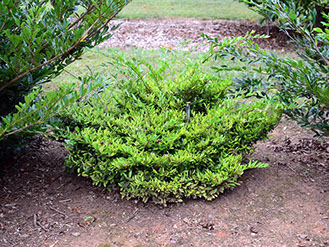
Eight clones of Distylium chinese with lower growing habit and small foliage were evaluated in containers outside and two of them were survived without any cold damage. Bailey Nursery requested these two plants for further evaluation as potential new releases.
With protection of winter houses, all eight clones are transplanted to bigger pots and will be grown as breeding lines. Existing cultivars from Distylium racemosum and D. myricoides will be utilized as breeding sources too. The targeted features will be compact habit, small dense and colorful foliage, and cold hardy to USDA zone 7.
Loropetalum, especially dark foliage and red flower ones are very popular in the market and more than 60 named cultivars have been documented. We will manage to collect all existing cultivars and use them for comparative evaluation and breeding. We hope to breed dwarf, dense, and heavy bloom, especially cream yellow flowers on the purple foliage, cultivars for the demand market.
Both Distylium and Loropetalum are members of Hamameliaceae and several other members of the family, such as Corylopsis, Disanthus, Exbucklandia, Fortunearia, Hamamelis, Parrotia, Rhodoleia, Sinowilsonia, and Sycopsis, have been grown for our breeding programs too. A spectrum of winter, early spring, late spring, summer, and fall blossom plants should be created through interspecific and intergeneric cross hybridization.
Interspecific Hydrangea
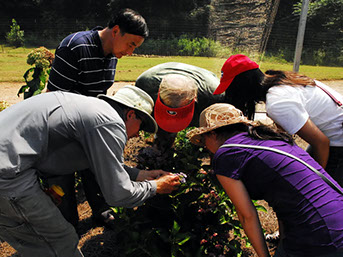
Many new cultivars within a Hydrangea species are on the nursery market and interspecific cultivar has limited successful reports. Since no interspecific cultivar is in the trade, we will focus on our breeding among the species of Hydrangea arborescens, H. macrophylla, H. paniculata, and H. quercifolia. Hydrangea paniculata has been tested in USDA zone 3 and widely cultivated from zone 4-9. Our goal is to introduce the cold hardiness genes to the colorful Hydrangea macrophylla plants (Reed, 2002) and produce some novel cultivars for the market.
The difficulty of conducting interspecific hybrids is the incompatibility, which leads the abortion of fertilized ovaries. From 16 cultivars of Hydrangea paniculata, 6 cultivars of Hydrangea macrophylla, 3 cultivars of Hydrangea quercifolia, and 2 cultivars of Hydrangea arborescens in our collection, we will make reciprocal crosses and rescue their embryos in vitro after 6-8 weeks. Both embryogenesis and embryo germination will be experimented and we expect to have some new hybrids in the container and field trials. The cultivars with better flowers, compact habit, and no cold damage will be selected as potential new releases.
Mr. Yibu Lu, a visiting scholar from China, is working on this project. He will make controlled crosses, conduct embryo rescue, collect and germinate seeds, and evaluate siblings in container and field. The cooperative training will help Yibu’s career as a Hydrangea breeder. He will definitely have better understanding of breeding line collections and bring more wild Hydrangea germplasm resource from China to the gene pool.
Superior Nandina domestica
From a potential new release of Nandina domestica ‘Gulfstream 02-02’, we collected the limited seeds and germinated them in the last two years. The seedling population showed three very distinguished colors (red, orange, and lime) in the fall and winter. Bailey Nursery requested six plants each and propagated them by cuttings. We will continue to evaluate them in the container and field for their compactness and outstanding fall colors. We will continue our selection of superior Nandina clones from the open pollination seed.

Cold Hardiness Gardenia
Gardenia gains popularity in the recent years because of its evergreen compact habit and fragrant flowers (Dirr, 2011). Unfortunately, all current cultivars had heavy cold damage last winter. From a seedling population of Gardenia jasiminoides in the Horticulture Farm, one plant showed very little damage and performed well in the spring. We will propagate it from stem cuttings for further evaluation. Fruits (open pollination) will be harvested from this clone for further selection. The bottom line is to introduce some new cultivars, which can tolerate the cold in USDA zone 7.
Evergreen and Fragrant Viburnum
Evergreen Viburnum with fragrant flowers has been requested by the nursery industry for a while. We have collected Viburnum awabuki, V. davidii, V. nudum, V. oliganthus, V. tinus, and V. burkwoodii and several other species for cross hybridization. We will make many controlled crosses and harvested cross hybrid seeds. If in any need, embryo rescue will be employed for these controlled crosses. Some deciduous Viburnum will be included in the pool to improve the possibility for generating new cultivars.
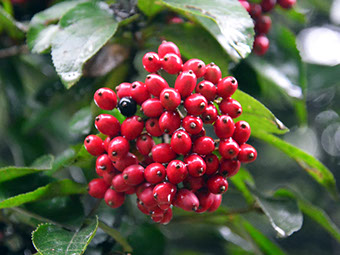
More Lagerstroemia
Open pollinated seeds from more than 30 Lagerstroemia cultivars, including newly released dark purple foliage “Ebony” series from USDA, have been collected and more than 1,300 seedlings have been transplanted for further evaluation and breeding. The goal is to select clean foliage (disease resistance) and bright flower clones with habit from groundcover to small trees.
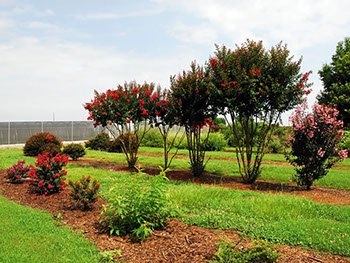
Dwarf Magnolia for Container Production
The limitation of Magnolia as a container crop is the cold hardiness and performance in containers during the production. Majority of evergreen species is less cold hardy, while deciduous species is generally too big. With discovery of groundcover Magnolia figo var. crassipes and successful crosses among species from Magnolia, Manglietia, Michelia, Parakmeria subgenera, we will conduct controlled crosses among the evergreen shrubby species to cold hardy deciduous species. The goal is to breed novel cultivars for both container production and better landscape performance.

Mr. Kevin Parris is an instructor at Spartanburg Community College and a Ph.D. student at Clemson University. He is working in my lab on better understanding the genetic diversity of Magnolia hybrid seedlings. He has done thousand of controlled crosses and will continue to make crosses in the Horticulture Farm and the University of Georgia campus. After he completes his Ph.D. work, he will be an outstanding plant breeder and Magnolia expert. Also, a visiting MS student from China, Mingmei Wang, is trained on making proper controlled crosses of Magnolia.
Various Camellias
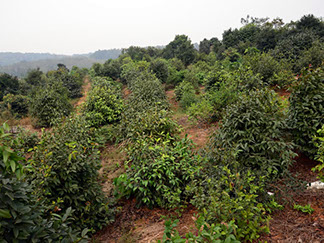
Two visiting professors from China, Dr. Jiyuan Li and Dr. Yun Xie, are the Camellia experts. They brought golden, red, azalea, edible oil, and beverage camellia species to our breeding programs (Ma et al., 2008). We will not work on Camellia japonica and Camellia sasanqua and our goals are conducting cross hybridizations among these new species and creating novel ornamental cultivars beyond common Camellia japonica and Camellia sasanqua. Camellia oleifera are widely cultivated in China for its edible oil production (Zhang et al., 2008).
Camellia sinensis has been cultivated in China for thousand years as beverage (tea). Through the collaboration of our Chinese visiting professors, we can request many elite cultivars from China and evaluate them here under the Georgia environmental conditions. It is very important that we will have our novel selections for the oil tea and beverage tea industries. We can also promote them as alternative horticultural crops for Georgia and the southeastern US with our outstanding new selections.
Anneslea, Ternstroemia, and Tutcheria are members of Theaceae too. We have collected several species for further evaluation and potential hybridizations
Alternatives and Under Utilized Landscape Shrubs
haphiolepis indica is a popular landscape shrub for mass and row plantings. However, its black pomes are not ornamental, especially under the stress conditions. When I first looked at Photinia integrifolia plants, I mistakenly identified it as Rhaphiolepis. Later, its bright red pomes attracted my attention and we started to evaluate it as an alternative for Rhaphiolepis and made some crosses with other Photinia and Rhaphiolepis. The goal is to produce rounded plants with dense and clean foliage.
Osmanthus fragrans has more than 80 registered cultivars in China and only a few available in the US. With their excellent performance in our test beds, we will acquire more cultivars and conduct the controlled breeding. Sarcococca is a shade love plant and does well under Georgia conditions. More selections and breeding will initiate for dense and disease-resistance new cultivars. Chimonanthus praecox blooms during the winter months (Zhao et al., 2007). We have collected seeds from its red, pink, and double flower cultivars and test them for Georgia growing conditions.

Cephalotaxus is one of my favorite plants and I promoted one of the lower growing plants with dense branches and radiated foliage while I was the Ph.D. student. After 20 years, the original plant is about 2’ tall and 3’ across. It is a great plant in the landscape and deer does not touch it at all. We will collect stem cuttings and establish production protocol for nursery growers. This clone performs greater than any available Cephalotaxus and should be released as a new cultivar.
Miscellaneous Ornamental Trees
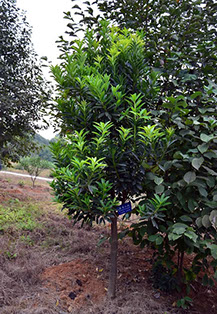
Populus deltoids, a new collection from China, has very attractive purple foliage during entire growing season and Bailey Nursery is testing its potential for the ornamental plant market. We will continue to induce the mutation and breed potential new releases with various foliage and habit.
From six seeds I collected from China, three of Celtis julianae seedlings showed golden foliage in early spring. During the summer, two of them kept the golden foliage and no damage from the direct sunlight. Celtis is a great shade tree, which can adapts poor and compact soil well and tolerates drought conditions. We will root stem cuttings and test this plant as a potential new release as a shade and landscape tree.
A row of Quercus nuttallii seedlings at the University of Georgia campus showed tremendous variations. A vigorous clone with dense and dark foliage and a clone with new red sprout are targeted as new clones. We will root stem cuttings from both trees and evaluate their performance in the field. If their outstanding traits are persistent, we will introduce them to the industry for further evaluation.
Symplocos tetragona, Phoebe spp., Fraxinus carolinana, Carpinus shenshiensis, Zelkova schneiderana, and several other tree species with superior clones are also collected for further evaluation as potential new releases.
Edible Landscape Plants
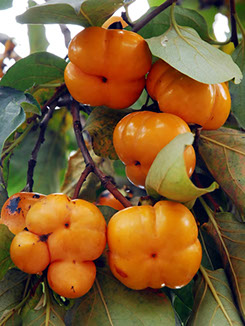
A clone of Diospyros lotus is a seedless shrub or small tree, which can produce wonderful red berries for ornamentals and edible fruits. We will germinate Diospyros virginiana seeds as stock plants and collect scion wood from this clone. Grafted plants will be evaluated for their performance under Georgia conditions. Two grafted plants survived from the last cold winter and will be used for scion wood sources. Many plants will be grafted for nursery evaluation. We hope to release this new clone as the edible landscape plant.
Seeds of five Myrica rubra cultivars have been collected and germinated in the greenhouse. Seedlings will be planted in the field and tested for their cold hardiness. Only one plant from previous seed collection is alive after the cold winter. We will collect more seeds from its northern provenance of China and select some female clones with dense dark green foliage and tasted fruits as our new releases under edible landscape plant group.
Ziziphus jujuba ‘Dongzao’ and ‘Tiancuimi’ were planted last year as potential edible landscape plants for their shrubby habit and delicious fruits. ‘Tiancuimin’ survived from both cold winter and late frost while new sprouts of ‘Dongzao’ were killed by late frost. Fortunately, one out of six ‘Dongzao’ plants initiated new growth. We will make some crosses between cultivars with tasted fruits and ornamental traits, such as twisted twigs, pendulous stems, and dense shrubby habit.